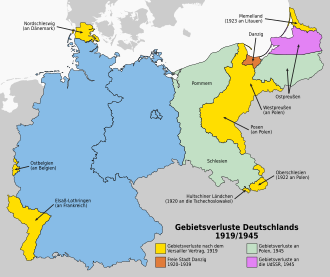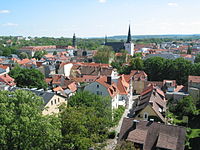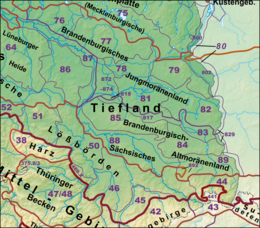East Germany
East Germany refers to the east of Germany . The term has several geographical, political, and socio-cultural meanings that are not congruent. By the end of World War II were as East Germany commonly the east of the Elbe lying parts of Germany referred ( Ostelbien ). This meant only the Prussian provinces East Prussia , East Pomerania , West Prussia , Silesia and the Province of Posen , east of the Oder . After 1945 the expression had a double meaning, as the area of the Soviet occupation zone and, from 1949, the GDR were also called that, while the old meaning in the West German Federal Republic continued to be used. The territory of the GDR was designated as Central Germany . The distinction between East and Central Germany played a role not least in the discourse between the expellees' associations and their affiliated cultural institutions. Nowadays East Germany is used as a synonym for the New Lands in the political and economic sense .
Conceptual and territorial history until 1945
Until 1919, East Germany was understood to mean the region east of the Elbe, and occasionally the Oder. These areas, which belong to the historical Germania Slavica , were mainly under Prussian influence in the north. East Prussia , Pomerania and the Neumark were Protestant and conservative . Silesia , West Prussia and Warmia were predominantly Catholic, the border region Posen-West Prussia was mixed.
In terms of territory, the Upper Saxon Circle of the Holy Roman Empire largely coincided with today's East German area complex.
The five new federal states, now trading as East Germany, are traditionally based on the historical state structures that were previously formed on their current territory. The historical forerunners of today's new federal states had been formed as part of the Holy Roman Empire since the Middle Ages.
These were the Electorate of Brandenburg , today according to the State of Brandenburg, the Electorate of Saxony , today according to the Free State of Saxony, the Ernestine Duchies , today according to the Free State of Thuringia , Mecklenburg-Strelitz and the Duchy of Mecklenburg , which are core parts of the State of Mecklenburg-Western Pomerania and which Anhalt principalities, which are important traditional founders of today's state of Saxony-Anhalt.
Two of the states, Brandenburg and Saxony, held the electoral dignity and thus had a strong political position in the empire. In the Middle Ages and in the early modern period, the area of today's East Germany tended to be less populated than the areas of the old Reich along the Rhine. A long lasting growth process from the 16th to the 18th century led to a gradual adjustment of the situation to the western part of the empire. Initially, the Electorate of Saxony, as a state with a prosperous commercial economy and pronounced trade, held the political leadership in the Upper Saxon Empire. This role was transferred to Brandenburg around 1700, which had expanded further east and west in the 17th century and, as a military state, rose to become a major European power in the 18th century. In the course of this, the political center of the German states, starting from the Rhine and southern Germany, moved in the 19th century to East Germany, the final capital of the Reich, Berlin .
Settlement and cultural history

In terms of settlement history , in the High Middle Ages there was a strong eastern settlement coming from the Rhine to the east of the Elbe, in which the local Elbe Slavic population merged with the culture of the Flemish-Dutch-German settlers. In terms of cultural history , the natural historical landscapes were formed in East Germany during the High Middle Ages . These include, for example, the Altmark , the Mittelmark , the Uckermark , the Prignitz , the Lausitz , the Fläming , the Vogtland and others. The first metropolises in this area were Magdeburg as a center of the Reformation in the Middle Ages and early modern times , Leipzig as the international hub between Via Imperii and Via Regia , Brandenburg an der Havel as the early capital of the Mark, Frankfurt (Oder) , Rostock and Erfurt . The current delimitation of East Germany cannot, however, easily be transferred to the Middle Ages, as the areas west of the Elbe already belonged to the Germanic tribal duchy of Saxony and those west of the Saale to Germanic Thuringia . The Elbe-Saale line must therefore be taken into account when making statements about the history of East Germany. The Slavic tribes to the west of this border were assimilated or displaced by the Germans much earlier than those east of the two rivers.
The area known today as East Germany has functioned since the Middle Ages, primarily via the two European trade routes Via Regia and Via Imperi, as a central interface to the land for the exchange of goods, knowledge and people between all four directions of Europe and beyond.
| city | 1930 | 2017 |
|---|---|---|
| Berlin | 4,332,834 | 3,613,495 |
| Leipzig | 718.200 | 581.980 |
| Dresden | 649.252 | 551.072 |
| Chemnitz | 361.200 | 246,855 |
| Hall | 203,829 | 239.173 |
| Magdeburg | 307.935 | 238.478 |
| Erfurt | 141,735 | 212,988 |
| Rostock | 83,700 | 208,409 |
| Potsdam | 72,600 | 175,702 |
| Jena | 58,959 | 111.099 |
| cottbus | 52,081 | 101.036 |
In terms of intellectual history, the Reformation began in this area and spread from there to Europe. The most important intellectual centers of East Germany, which at the same time have a strong international reputation, were Wittenberg during the Reformation, Weimar during the Classical period, Halle as a center of Pietism in the early 18th century, Chemnitz as the starting point for German industrialization , Leipzig and Berlin at the beginning of the social question and the formation of the organized German labor movement in the 19th century, briefly Dessau with the Bauhaus . Today's Mecklenburg-Western Pomerania is called East Germany due to the GDR membership of the area, but historically has more coherence with other northern German areas than with those of southern former central Germany.
The accumulation of many artificial garden landscapes (e.g. Dessau-Wörlitzer Gartenreich ) since the early modern period is striking in terms of cultural history . This continues to this day (e.g. Lusatian Lakeland ).
A comparison over time of the development of the metropolises in eastern Germany in the 20th and 21st centuries shows a mixed, negative overall picture. Four of the five largest East German cities have lost their population over a period of 90 years. The metropolitan region of Central Germany has lost significant economic power, charisma, reputation and population in terms of contemporary history, starting from a leading international position just like Berlin. Since 1990, however, a slow revitalization process has started, whereby the previous relative position within Germany has not been achieved. In the 1920s and 1930s, the metropolitan region of Central Germany formed the second internationally significant population complex in Eastern Germany, alongside the agglomeration of Berlin. The so-called Saxon triangle, a particularly densely populated region in the form of a triangle between Chemnitz, Leipzig and Dresden, was also significant in terms of population and economic history . The total population of East Germany fell from 18.388 million in 1950, including East Berlin , to 15.120 million in 2000, including the projected proportion of the former East Berlin. The population decline was 3.268 million people or 17.8 percent. In 2010 the total population of eastern Germany based on the territorial status of 1950 was only 14.214 million people, a further decrease of 906,000 people in 10 years. The proportion of the population of East Germany in relation to the total German population decreased from 26.5 percent to 17.3 percent in the period from 1950 to 2010. The causes for the ongoing contraction process up to 2010 are diverse, but are mainly due to the transformation processes after 1990 and to the social change that went hand in hand with a falling birth rate. The continued emigration after 1990 intensified the decline considerably. Rural regions, which are suffering from obsolescence and housing vacancies, are particularly affected by the population decline. The urban centers have a significantly younger population on average.
Ethnically, East Germany was a transit area, the population of which absorbed many different influences. The oldest influence is the legacy of the Elbe Slavs, whose genetic inheritance continues to exist in the German population; to a lesser extent it has shifted to predominantly Slavic states today. In the course of the strengthening of the influences of the intellectual historical trend of nationalism since the 19th century, the open character of the cultural area decreased significantly without stopping the influx of foreigners, for example from Poland , as the mobility rate of people generally increased over the centuries . Due to a real social isolation between 1945 and 1990 compared to the Federal Republic of Germany, a catched up migration movement did not come about until 1990, on the one hand by foreign ethnic groups, especially from Russia and Ukraine, and between the former GDR and the areas of the FRG before October 1990 Significant migration losses for East Germany gave way to migration gains, which, however, were quantitatively far below the previous losses. Certain social indicators are gradually developed differently than in the old German areas. This is explained by the long-term consequences of the division of Germany .
In terms of urban planning history, the settlements in East Germany are mainly characterized by the architectural styles of the Renaissance, Historicism , Art Nouveau , Classicism , the beginning New Objectivity in the architectural architecture of the 1920s and 1930s, the socialist variant of Brutalism and the form-dissolving postmodern architecture since 1990. The historic city centers, in need of restoration around 1990, have been extensively renovated and preserved almost everywhere. A restoration of the lost urban building culture began in the city centers after 1990. The restoration of Dresden's old town or the center of Potsdam are significant examples of the development in recent history since 1990. The extensive socialist urban planning influences of the 1960s and 1970s could thus be reduced in the appearance of these cities. In small towns there was a strong tendency to demolish prefabricated buildings, in medium-sized and larger towns more moderate.
Historical geography
The same is the equivalent of Eastern Germany Rhein West Germany. The river flows through the area centrally and completely and is a sufficiently significant stream. In the early Middle Ages, the cultural boundary between the Germans and Slavs ran here.
In terms of cultural geography, there were two areas in East Germany in the early modern period up to around 1800, the more densely populated and commercially dominated southern part, essentially consisting of Thuringia, Saxony and southern Saxony-Anhalt, and the northern agricultural part, consisting of northern Saxony- Anhalt, Brandenburg and Mecklenburg-Western Pomerania. Both areas had different agrarian constitutions with different types of lords and a differently developed urban bourgeoisie. In particular, the two defining territories of East Germany, Brandenburg, which represented the northern part, and Saxony, which represented the southern part, had different mentalities. In Saxony, a differentiated and more permeable social structure developed, comparable to southern Germany, in Brandenburg class boundaries and an absolutely active central state were the determining characteristics.
Geographical settlement centers are and were the Havel region with the center Potsdam-Berlin, the middle Elbe, the Saale-Unstrut region and the Baltic Sea coast. Mining in the Ore Mountains played an important role, especially in the early modern period. Lignite deposits in central Germany were important for economic development in the first half of the 20th century.
post war period
After 1945, and especially after the division of Germany in 1949, the use of language changed , and in West Germany the term “German Eastern Territories” was officially used to refer to the Eastern territories of the German Reich . In official parlance, the application of the term East Germany to the German Democratic Republic (GDR) was avoided, which was also due to constitutional and international law reasons. In addition, in the Federal Republic of Germany there were the terms Soviet Occupation Zone (SBZ) and later Central Germany as substitutes for the frowned upon term "GDR", but more often zone, over there, Soviet zone, eastern zone, "GDR" (with quotation marks ) or so-called GDR . Only with the new Ostpolitik and the treaties with Poland on the Oder-Neisse border also changed the designation from East Zone to GDR and German Democratic Republic , but not to East Germany in official use . In parts of the West German press, however, the term East Germany was used as a synonym for the taboo word “GDR” in the first few years of the Federal Republic's existence .
After reunification
Since the accession of the GDR to the jurisdiction of the Basic Law of the Federal Republic of Germany in October 1990, the former is the territory of the GDR as former GDR (former East Germany) , legally Lander or as new countries (not applicable to East Berlin), respectively. In February 2004, the Schlesische Nachrichten claimed that the designation "East Germany" for the eastern areas of the German Reich was "dead" due to a "language requirement of the federal government ". The use of the term "East Germany" for the areas formerly east of Central Germany was, however, extremely seldom in common usage between 1990 and Gerhard Schröder's inauguration in 1998.
The term East Germany for the new states is used in the Tagesschau and in statistics of the economy. On the basis of their shared history, language and culture, Mecklenburg-Western Pomerania is often referred to as "Northeast Germany" or as part of "Northern Germany" and less often Thuringia with parts of Saxony-Anhalt , Saxony and / or Hesse are referred to as "Central Germany". These terms correlate roughly with the spatial distribution of Low German and Central German dialects.
East German plateau and heathland
The eastern part of the central North German lowlands is now naturally referred to as the Greater Region 3rd Order East German Plateau and Heathland. This is divided into the following sub-spaces:
- Mecklenburg-Brandenburg plateau and hill country (D05)
- 79 East Brandenburg plate (D06)
-
(to 80 Odertal (D07))
- Main units 802 and 803
- Brandenburg Heath and Lake District (D12)
- Lusatian Basin and Spreewald (D08)
- 85 Fläming (D11)
- 86 Wendland and Altmark (D29)
- 87 Elbe valley lowlands (D09)
- 88 Elbe-Mulde-Lowland (D10)
- 89 Upper Lusatian Heideland (D13)
To different language usage
In Thuringia, there is sometimes a lack of understanding when the residents are referred to as "East Germans" by the media - with reference to their geographical location in the center of Germany. So for example, is Erfurt Western as Regensburg and Munich as well, even Eisenach west of the geographical center of Germany and some 220 kilometers to the west as Passau . In this respect, residents of the individual areas feel more like they belong to a specific, geographically delineated and historically grown region, instead of belonging to two parts of Germany that were formerly separated by the “ Iron Curtain ”. They also see the language used in East Germany as a sign of a natural process of the merging of formerly two states. For this reason, the term refers to the political level of the reunified Germany, especially among the older population .
Leaning (now in the RBB risen) East German Rundfunk Brandenburg (ORB) is sometimes only the territory of the country Brandenburg , Berlin (and partly Mecklenburg-Vorpommern and parts of Saxony-Anhalt ) as (North) East Germany considered.
The term Central Germany is also in use. This term appears to be correct in the orientation primarily to the linguistic differences in the north-south direction (for example Upper German , Central German and Low German language areas) as well as historically and economically in all directions ( Central German chemical triangle , today the metropolitan region of Central Germany ). The Mitteldeutscher Rundfunk has named itself in this sense.
In English -speaking countries, the term " Eastern Germany " common "East Germany" whereas the former GDR and "former eastern territories of Germany" or "the historical Eastern Germany" today to Poland or Russia belonging to former German territories ( Silesia , Pomerania , Neumark , West Prussia , East Prussia , Danzig and Posen ).
Web links
- East Germany in the online encyclopedia on the culture and history of Germans in Eastern Europe of the Carl von Ossietzky University of Oldenburg
- Klaus-Rüdiger Mai : Everything begins with origin - which is why Eastern Germany is developing into a provocation (NZZ, September 3, 2018)
Individual evidence
- ↑ http://pdwb.de/nd06.htm
- ↑ Germany: 1950: 69.346 million, 2010: 82 million inhabitants
- ↑ E.g. Section 256a of Book Six of the Social Security Code .
- ↑ Herbert Hupka : ( Page no longer available , search in web archives: Progressive Exclusion , Schlesische Nachrichten. February 15, 2004 )
- ↑ See also BVerfGE 102, 68 (96); 102, 254 (304, 333); 104, 126 (148); 107, 218 (246, 253); 110, 177 (186); 112, 368 (399); 113, 167 (226, 248); 116, 96 (125); 117, 272 (297).





